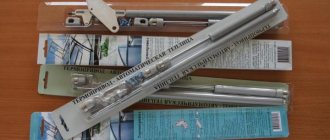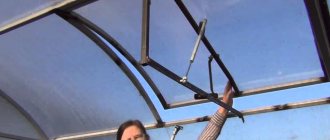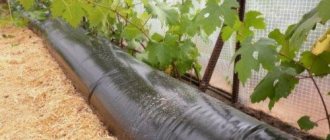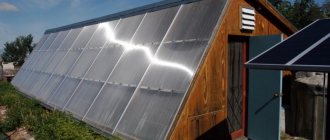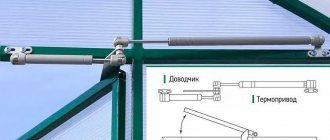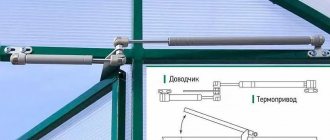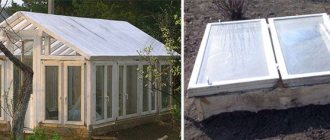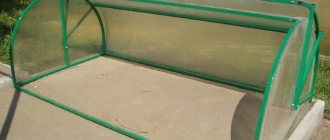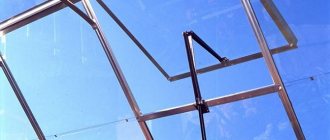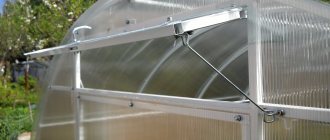Automatic opening of the greenhouse: operating principle
Modern production of components for automated greenhouses offers gardeners many options, varying in size, appearance, efficiency and cost.
Today, automation for greenhouses according to the principle of operation differs in:
- Hydraulic installations. Such openers work on the principle of increasing pressure in containers with liquids when exposed to high temperatures. Hydraulic systems are the safest. Their disadvantages include a delay in closing the transoms, which can negatively affect the condition of the plants.
- Electrical. Such systems are the most accurate, easy to install and do not take up much space. The downside of the devices is the need for a permanent connection to the power grid. If the greenhouse is fully electrified, to eliminate the possibility of the devices stopping, you can purchase an electric generator.
- Bimetallic. Opening and closing in the case of bimetallic systems is based on the ability of metals to expand. Such installations can be used to automate homemade windows on a wooden frame: they will not be able to open heavy transoms or doors.
You can equip any window (top and side) and door with automation.
Manufacturers
Do-it-yourself rack: options and diagrams on how to make a high-quality rack quickly and easily
Now let’s make a short review of products for ventilating greenhouses from various companies. There are a number of automatic devices on sale today that operate on the various principles mentioned above. Any model that will be described is quite easy to install yourself. But if we are talking about electrical solutions, then it would still be better to contact a specialist.
"Dusya San"
So, the first option I want to talk about is “Dusya San”. This option uses a thermal cylinder operating on a hydraulic principle. This model operates at a temperature of no more than fifty degrees. The weight of the largest window that this device can open is seven kilograms. The machine is sold fully equipped, in addition to it comes with installation instructions.
Installation can be performed in various greenhouses. The main thing is that the window works clearly both for closing and opening. The opener does not require batteries or an electrical connection. In this case, the ventilator can be easily adjusted to open the window in the required temperature range. If the temperature rises to 30 degrees, then the window opens all the way.
"Sesame-M-2015"
Another interesting option is called “Sesame-M-2015”. The main element of this system is a hydraulic cylinder filled with oil. This model works over a wide temperature range and can be easily adjusted. The weight of the product is only one kilogram, but this is enough for the thermostat to easily open heavy oversized windows and doors. To avoid false operation of the system from overheating, you can protect it by installing special umbrellas on the street side.
"Thermal drive"
The next model is “Thermal Drive”. This development of a domestic manufacturer from Krasnoyarsk can open a window or door weighing up to twenty kilograms. But it is better to use it on window and door structures weighing up to ten kilograms. The largest opening angle is 45 degrees.
This design works using a hydraulic-type thermal cylinder. The manufacturer provides a twenty-year warranty on its products. It is quite simple to install such a system yourself - the instructions contain a similar installation diagram for this model.
Open Planet
Another solution that I would like to talk about is called Open Planet. The manufacturer guarantees that this device creates an ideal microclimate in the greenhouse for cultivating plants. Thanks to it, the temperature in the greenhouse can be adjusted in the range from 15 to 25 degrees.
This model has a reinforced structure with two springs, which makes it possible to use it not only on windows, but also on doors. The car ventilator is made of stainless steel. But in the cold season it is better to dismantle it so that the cylinder does not become deformed.
We make a thermal drive from a hydraulic cylinder from a car
The hydraulic cylinder from the car is gas, and therefore requires some modification.
- We drill into a hole and release the gas.
- We cut a 10x1.25 thread there to connect the hose - it’s better to take a long brake one for the Niva, which can be found at any auto store. We fasten it with a bolt with an M6 pin on the head - the same as it was on the bottom of the cylinder. This is necessary in order to secure the hinge head in its original place.
- We make it ourselves or order a receiver for the thermal drive from a turner.
- We displace the air and fill it with oil. The cylinder rod must be completely recessed at the temperature of the entire system.
- We carefully check the entire system for leaks.
If you don’t know what a hydraulic cylinder is, then this video is for you:
Principle of operation
How to make a mini-greenhouse on a windowsill?
The thermal drive reacts to changes in temperature in the greenhouse. The device opens doors, windows, and vents when the temperature rises above a certain value. Additional ventilation of the room occurs, as a result of which the temperature regime is normalized. In this case, the actuator element of the thermal drive returns to its original state with the onset of cold weather.
According to the methods of operation that drive the thermal drive mechanism, the following are distinguished, differing in physical principles.
- Electric thermal drive. The main elements of this device are an electronic control unit (controller), temperature sensors and fans. Information from temperature sensors is analyzed by the controller and the program selects the most rational mode of operation of ventilation units. The operating efficiency of an electric thermal drive does not depend on the size and type of greenhouse construction. In the greenhouse, the desired temperature regime is quickly adjusted. However, the need for power supply limits its applicability, especially in suburban areas remote from cities.
- Thermal drive based on the difference in linear expansion of metals. Such a system consists of a bimetallic plate into which metals with different linear expansion coefficients are collected. When heated, such a plate bends and puts pressure on the actuator, which opens, for example, a window. Independence from external factors (power supply), ease of installation and low cost of operation are the main advantages of this system. The disadvantages are the transfer of a large amount of heat to ensure performance (thermal inertia), low power and the difficulty of selecting materials that work well in a given temperature range.
- Thermal drive based on the principles of hydraulics and pneumatics. The difference between them lies in the state of the working fluid - liquid or air.
At a certain temperature, for example, about 22°, a special liquid begins to expand strongly and forcefully push out the rod connected to the window, vent or door. When the temperature drops, the rod returns using a return spring. Along with independence from the power source, another advantage of such a thermal drive is ease of installation and the ability to work with massive structural elements of the greenhouse. Expensiveness and slow closing when the temperature drops sharply limit its use for small greenhouses.
Kinds
Reinforced film for greenhouses
Now let's move on to the types of automatic ventilation installations. As already mentioned, such mechanisms are divided into independent solutions and energy-dependent autotype options. Energy-dependent solutions are attracting considerable interest today. As a rule, the essence of such systems is to operate from the mains and, somewhat less frequently, from solar batteries or some other alternative energy sources. Such devices are usually used to operate a thermal relay, which can activate fans, providing a flow of fresh air into the greenhouse.
Independent solutions, in turn, are divided into three categories:
- based on pneumatics;
- bimetallic;
- based on hydraulics.
Now let's analyze each machine more carefully. The bimetallic version for greenhouses works according to the following algorithm: when exposed to a certain temperature, a linear type of material expands. This design provides for the presence of two types of materials, and the essence of the work lies in their different expansion coefficients. That is, when the temperature rises, the thermal drive in automatic mode opens the vents and doors in the greenhouse, and when it decreases, it closes them. In this case, automation has only one drawback - it is difficult to select the required temperature so that ventilation is carried out efficiently.
The hydraulic option for ventilating greenhouses has a number of advantages:
- absence of unpleasant odors or their minimal amount;
- no dependence on electricity;
- easy to assemble by hand;
- there is no need to constantly be near the greenhouse;
- the ability to work inside under comfortable conditions.
This system is considered one of the most reliable.
It should be noted that the auto mechanism for hydraulic ventilation also has some disadvantages:
- great inertia;
- high price;
- the temperature can only be monitored where the system is located.
This machine has a fairly simple design. The hydraulic cylinder begins to move only when there is a difference in the temperatures of the oil and the capacitive material. That is, it turns out that the rod is slowly being forced out. And it is the hydraulic drive that will open the window. To obtain optimal conditions in the greenhouse, allowing you to effectively care for the plants, you will simply need to set a certain temperature. The door automatic opens the door itself when the temperature becomes higher than planned.
Before purchasing a hydraulic universal auto-ventilator for greenhouses, you need to pay attention to the following points
- Price. Such machines are necessary for every window and door in a greenhouse. The price of one unit of construction will be approximately three and a half thousand rubles.
- Power. You should know exactly how much power is needed to lift a particular element in a greenhouse.
- It is also necessary to know the weight of the machine that the greenhouse structure can support.
The pneumatic version uses thermal energy. Its main advantage is that it is completely independent of any other energy sources.
Other advantages of this option include:
- serious performance;
- low price.
It also has a number of disadvantages, namely:
- low working effort;
- greater inertia;
- dependence on atmospheric pressure indicators;
- bulkiness.
There are also electric models of self-ventilators for greenhouses, which were mentioned above.
Such systems are very convenient due to the fact that they have:
- excellent electric drive power;
- precise and convenient adjustment system.
They are perfect for greenhouses where there is a need to use complex and multi-stage ventilation systems. The main elements of such systems are a thermal regulator, which is responsible for turning the system off and on, as well as an electric ventilator. The main disadvantage will, of course, be dependence on the availability of electrical energy.
How and from what to make it yourself: options
The advantage of creating a thermal drive with your own hands is the possibility of using available materials. It is enough just to prepare all the necessary details for this.
A very convenient and simple means for making an automatic thermal drive is an office chair. How often have you raised or lowered your seat to the required level while working at the computer? This was possible thanks to gas lift. Sometimes it is also called a lift cylinder.
To make a thermal drive for a greenhouse with your own hands from this part of an office chair, perform the following manipulations with it.
- The cylinder consists of two elements: plastic and steel rods. The first stage of work is to get rid of the plastic body, leaving only the second, more durable one.
- Having put the spare part from the main piece of office furniture aside, pick up a metal rod with a diameter of 8 mm. Fix the part in a vice so that there is a section of about 6 cm on top.
- Pull the prepared cylinder onto this rod and press as hard as possible so that all the air comes out of the latter.
- Cut off the tapered end portion of the cylinder and push the steel rod through the hole. Be careful not to damage the smooth surface and rubber clamp.
At the end of the rod it is necessary to make a thread that will fit the M8 nut. Now the extruded liner can be returned to its place, being careful and protecting the aluminum piston. We insert the steel rod into the inner sleeve and pull it out from the back of the cylinder. To prevent the piston from moving out or falling inside the cylinder during operation, screw an M8 nut onto the prepared thread. Insert the aluminum piston into the valve seat. Weld a steel tube to the cut end of the cylinder. Attach the resulting mechanism to the window control unit. Bleed all the air from the system and fill it with oil (can be machine oil). Thermal actuator for a greenhouse made from office chair parts is ready for use
All that remains is to test the device in practice and use it
Thermal actuator for a greenhouse made from office chair parts is ready for use. All that remains is to test the device in practice and use it.
Of course, making such structures with your own hands is a very labor-intensive process. But the result of painstaking work and care will exceed all expectations.
Another handy tool for creating an automatic greenhouse ventilation system is a regular car shock absorber. The main active ingredient here will also be motor oil, which reacts very subtly to minor temperature changes, which powers the entire mechanism.
The thermal drive for the greenhouse from the shock absorber is performed in a certain sequence.
- Prepare the necessary materials: a car shock absorber gas spring, two taps, a metal tube.
- Near the window, the opening and closing of which is planned to be automated, install a shock absorber rod.
- The third stage will be preparing the pipe for machine oil. At one end of the pipe, attach a tap for the supply of engine fluid, and at the other end, the same structure, but for draining it and changing the pressure in the system.
- Cut the bottom of the gas spring and connect it to the oil pipe.
The thermal drive from parts of a car shock absorber is ready for use. Monitor the oil level in the tube to avoid incorrect operation of the system.
After talking with professionals, rummaging through your unnecessary spare parts in the garage or shed, you will find a large number of necessary parts to create your own thermal actuator design. If the installation of finished products is carried out as quickly and simply as possible, then even making your own mechanism with a closer or a lock will not be difficult for you.
After putting the system into operation, it is necessary to take care of it so that it also justifies its peculiarity in terms of the durability of the mechanism.
Making an automatic control system at home
Nothing is impossible
Hydraulic cylinder.
Yes, you can, moreover, a hydraulic cylinder is a complex and responsible mechanism, and yet we will tell you how to completely independently make several options for ventilating greenhouses with its help.
Our information is that many readers who have read the article to this point may think that they are not able to make a hydraulic cylinder at home and will regret the time spent reading this article. Take your time, we assure you, we will tell you about two options for manufacturing this system. We are confident that anyone can make one of them.
The simplest pneumatic-based regulator
First, let's build the simplest device. To manufacture a hydraulic cylinder operating on liquid, it will be necessary to perform numerous operations using specialized equipment, so we will make the first hydraulic cylinder operating on air.
Although this device may seem simple at first glance, nevertheless, it will successfully perform its functions of ventilating the greenhouse.
Materials – all at hand
- To make a hydraulic cylinder, we need a piece of tin, polycarbonate or other available material.
- The main condition is that it can be used to make a cylinder with a diameter of 200 mm.
- To do this, you can successfully use a piece of plastic pipe used for sewer installation.
Making a cylinder
Diagram of a pneumatic cylinder.
Having bent a cylinder from tin or polycarbonate (See Which polycarbonate is better to choose), it can be fastened using ordinary tape. There are many options, we will not consider them.
We have a cylinder with a diameter of 200 mm and a length of 300 - 350 mm .
- The lower part must be sealed. The easiest way is to use a piece of foam.
- If your cylinder is made from plastic pipe, you can also use polystyrene foam, but it is best to use a piece of perspex that is 5mm or thicker.
- To do this, a circle is cut out of plexiglass of such a size that it covers the cylinder on one side. We will need two such circles.
- From one circle we will make a plug for the hydraulic cylinder, and from the other a guide for the rod.
Next is the rod and piston
Next you need to make the piston. Penoplex is suitable for this. You can make a piston from the material from which you made the plugs, it doesn’t matter. The main thing is that the material is sufficiently rigid.
- The diameter of the piston must be such that it moves freely in the cylinder. A small gap of 1 - 2 mm is only beneficial.
The rod for the hydraulic cylinder can be made of wood.
We suggest using the following sizes:
- Length 500 mm
- Diameter 40 mm
- Plane the rod well and sand it with sandpaper.
- To avoid wood swelling during work, treat it with a protective agent.
- If you do not want to use a wooden rod, you can use a piece of plastic pipe, usually used for plumbing, to make it. Take a size 32 pipe.
There was a cylinder, now there is a pneumatic cylinder
We continue to make the cylinder. We have two stubs.
- You need to drill holes in them exactly in the center. Moreover, one has a diameter of 10 mm, and the second has such a diameter that the rod we have can slide freely in it.
The holes are drilled and the cylinder needs to be assembled.
- A plug with a 10 mm hole is attached to one part of the cylinder. This plug must be firmly installed. Therefore, it is better to put it on epoxy glue or secure it in any way convenient for you.
- In addition to all of the above, we need an airtight chamber. You can use a ball chamber or an inflatable ball made of plastisol. Sold in almost all children's toy departments.
- You can use a medical system as a hose; you can purchase it at any pharmacy.
Ball, football camera, medical equipment - everything is in use
Assembling the regulator cylinder
You can assemble our hydraulic cylinder.
- Connect the ball to the hose and secure firmly. The connection must be tight.
- Place the ball inside the cylinder, having first threaded the hose through the hole in the plug.
- Connect the piston to the rod. The rod must be mounted exactly in the center of the piston.
- Insert the piston into the cylinder. In this case, the piston will press the laid ball.
- Now if you start pumping the ball with air through the hose, the piston will begin to move, moving the rod.
- In order for the rod to move strictly in one direction, it is necessary to install a guide.
- To do this, the rod is threaded through the guide hole and the guide is attached to the hydraulic cylinder.
Our advice is that in order to be able to service the hydraulic cylinder and change the inflatable ball in the future, secure the guide with tape. The fastening will be good and it will be easy for you to disassemble the hydraulic cylinder for maintenance.
We make a receiver
In order for our system to work as it should, we need an air receiver.
In this case, the larger the volume of the receiver we use, the better the effect we will achieve.
- Any thin-walled container is suitable for the receiver. You can use old paint containers or a regular 20 liter canister.
- If you use a canister, make sure the lid closes tightly.
- In the existing container, it is necessary to install two pipes suitable for the hydraulic cylinder hose.
- Using the first pipe we will connect the receiver to the hydraulic cylinder, and the second will act as a regulator.
- The pipes must be connected completely tightly. To do this, you can use epoxy glue or any other method convenient for you.
We assemble and test the regulator
Diagram of the greenhouse ventilation pneumatic system assembly.
The receiver is ready.
- We connect the hydraulic cylinder hose to one of the pipes.
- 100 - 150 mm long is put on the second pipe .
You can begin testing the hydraulic cylinder.
- In cool weather, start pumping air into the receiver through a free section of the hose.
- When the pressure in it rises, the hydraulic cylinder rod begins to extend, bend the hose used for pumping air and secure it in this way.
- As the ambient temperature rises, the air in the receiver will begin to heat up and expand, inflating the ball.
- That, in turn, will push the piston and rod. Work is happening.
- Once the air temperature begins to drop, its volume will decrease and, in turn, the pressure inside the system will decrease.
- Everything is clear, you can attach the hydraulic cylinder to the window of the greenhouse and use it for its intended purpose.
Device calibration
Temperature calibration is done using a free hose.
By changing the pressure inside the system, it is possible to ensure that the ventilation vents open and close strictly at a certain temperature.
Placing the device inside the greenhouse
Placing a hydraulic cylinder in a greenhouse. Possible scheme.
The system is very effective. The only drawback of such a system is the low force of this hydraulic cylinder. Therefore, it can only be used for one window, and the window should open and close quite easily (see How to make a window in a greenhouse: tips)
- The receiver itself must be placed inside the greenhouse so that it is not exposed to direct sunlight.
- The best option would be when the receiver is located under the ceiling of the greenhouse, and its surface is covered by a sun screen.
This design is easy to manufacture, does not require special knowledge and scarce, expensive materials, however, it copes with its task perfectly.
The procedure for making a thermal drive for a greenhouse with your own hands
1. Carefully saw off the lower hinge of the rear support of the trunk with a hacksaw (the cutting line is shown in green in the picture). Please note that you cannot clamp the stop too tightly in a vice - remember that it is hollow inside, and if the geometry is broken, then the piston will jam).
More details
2. Drill a hole in the end (shown in the figure below by a green dot, metal drill 3.0, at medium speed with a regular drill). Be sure to drill with safety glasses and slowly, especially at the end: there is gas under pressure inside the stop! If you pass smoothly, you will hear a long “splash”, and if you go abruptly, it will be quite strong (you may splash a small amount of liquid from the stop - wear overalls).
More details
3. Cut the thread with a die (on the stop) and a tap in the pump housing (do not forget that you cannot clamp the stop too tightly in a vice!);
More details
4. Hermetically connect the pump housing and the stop using washers and FUM tape; plug the small hole with a bolt (you may also have to cut the thread) or a self-tapping screw. Seal the pump housing cover (quite simply: 2 washers, a bolt with a nut, FUM tape), it is more rational to make a hole here to remove residual air and excess oil. The small bolt can then be used to bleed out any remaining air or excess oil (if necessary).
5. Fill the pump (or pipe) 1/3 full with oil and pump the stop piston until all the air comes out, then push the piston completely into the housing. Add oil to the edges of the pump housing.
6. Screw on the top cover, remove any remaining air through the bolt, adding oil through a syringe. The automatic thermal drive for opening the vents and doors of the greenhouse is ready.
More details
Thus, I received a self-made thermal drive, spending 0 rubles. (no more than 400 rubles if you buy stops and a piece of pipe). Of course, it was assembled on the knee, but for free and from improvised means. The design is not perfect, but it works.
In my greenhouse there are two of these homemade thermal actuators on the top windows and one on the side. They worked perfectly throughout the 2015 season; minor oil leaks (squeezed out in extreme heat) did not affect their performance in any way. Moreover, there is simply nothing to break in them. Therefore, in 2016, I made two more such machines for the second greenhouse. In one of them, instead of a trunk stop, I used a leaked TP-440-DV drive (only the connection there is slightly different - through an adapter).
Hydraulic cylinder from spare parts for a machine
For vertical vents, a mechanism assembled from scrap materials is ideal. It is capable of lifting even the heaviest frames, as long as the windows swing open along a horizontal axis. To create it, you need to improve the automobile gas piston.
You will need:
- the hydraulic cylinder itself. Its role can be played by stops for the trunk of Moskvich, Niva, Zhiguli (models VAZ 2108, 2109) or hydraulic cylinders from trucks that lift the cabin;
- epoxy adhesive;
- drill.
Hydraulic cylinder for a greenhouse from a car stop
Stages of work:
- Drill a hole in the bottom of the stop. Be careful and wear glasses when working. Gas escaping from the hole may carry chips into your eyes.
- Using a large diameter drill, increase the hole to 9 mm.
- We press on the rod and push it into the cylinder so that the piston remains at a distance of 30-35 cm from the hole.
- We degrease the resulting cavity with a solvent.
- After the cavity has completely dried, we prepare the epoxy glue for work.
- For greater convenience, the cylinder should be secured in a vice with the hole facing up.
- The piston must be lubricated with oil so that it does not touch the grease-free walls.
- Now let's create a glue plug. Pour glue into the cavity so that it completely covers the hole.
- After the glue has dried, the piston must be moved away by pulling the rod. Since it's oiled, it shouldn't stick.
- In the same place, only in the glue, drill a hole with a diameter of 9 mm.
- We cut threads in it in increments of 1.25 using an M10 tap.
- We strengthen the finished device under the window so that the rod lifts the transom when extended.
Horizontal hydraulic cylinder for greenhouse
Design differences
The most common option in practice is the one where a liquid is used as a working fluid, which begins to expand greatly in volume at temperatures above 23°C. The device kit includes, in addition to the thermal drive, all the necessary elements for its installation:
- thermal drive assembly unit with an actuator;
- closer - a lever system that provides opening/closing of a door, window, window, greenhouse frame;
- a spring (there may be several of them), as an integral part of the closer, creating the condition for a smooth opening and using its elastic energy for closing;
- brackets for attaching to the frame of the greenhouse and the body of an object opened by a thermal drive (windows, vents, doors and other types);
- clamps for fastening the ball joints of the brackets to the ends of the thermal actuator and spring;
- fasteners, such as self-tapping screws.
In expensive versions of thermal actuators, gas springs are used instead of conventional springs, ensuring tighter and smoother closing.
Automation system for greenhouse ventilation “tuymazy”
The automatic device for ventilating greenhouses can be installed either on the greenhouse door or on the window - regardless of this, the device for ventilating greenhouses will work properly.
Main characteristics:
Window opening/closing temperature: 16-25.
Maximum weight of the window: 100 kg.
The window can be raised using a rod to a height of up to 40 cm.
Approximate price: 1500 RUR
You can buy it here
Types of main structures for greenhouse ventilation
Option #1 – electric
An electric automatic machine for ventilating greenhouses consists of a fan and a thermostat, which turns it on as soon as the air temperature in the greenhouse reaches a certain point. Their main advantage is high sensitivity and convenient adjustment, as well as unlimited power. They do not take up much space, can be located anywhere in the greenhouse, and the algorithm for their operation can be of absolutely any complexity - both simple and “smart”.
But the electric mechanism for ventilating the greenhouse is not reliable enough and depends entirely on the uninterrupted supply of electricity. For example, turning off the lights for just a few hours on a hot day can ruin a whole year's harvest. That is why it is advisable to take care of backup power in advance using an installed battery with recharging from a solar panel on the roof of the greenhouse.
Option #2 – hydraulic
The advantage of hydraulic devices is the autonomy and high reliability of the entire system. Hydraulic designs are simple, have great power and durability. They are a system of levers with a sensor connected to a transom.
The operating principle of this system is quite simple: as soon as the weight of one of the lever arms changes, the entire “yoke” tilts in the other direction and opens the transom. Then, when the air is sufficiently cooled, the reverse process occurs. Moreover, all the levers are two containers connected to each other like communicating vessels with just one flexible thin hose. The container that is inside the greenhouse is sealed and contains a sufficient supply of air - this is the “thermometer”.
But the container on the outside acts as a “weight” on the transom. Therefore, if the air inside the container is heated by the air in the greenhouse, part of the liquid is squeezed out into the outer container. It becomes heavier and opens the transom. And when the air in the greenhouse cools, the vapors inside the container are compressed again and the container sucks back the water. The outer one becomes lighter and the spring returns to the counterweight. Even a schoolchild can make such a pneumatic system. But it can only be used in a very small greenhouse or greenhouse.
But devices whose operating principle is based on the pressure force of an expanding liquid (be it water or oil) have serious disadvantages:
- In most ready-made models, transoms close under the influence of their own weight, and therefore this design cannot be used for the side windows of a greenhouse (unless you experiment with a spring).
- In the event of a sudden cold snap, the liquid in the cylinder cools down within 20 minutes, and all this time the transoms are still open, which is why cold dangerous air enters the greenhouse.
But, despite their disadvantages, hydraulic cylinders still have an undeniable advantage over other machines - for example, the ability to lift really heavy weights.
Today on the construction market there are many offers of high-quality “pushers” for greenhouse vents. They are all different in appearance, but their operating principle is the same - a small elongated hydraulic cylinder is filled with oil, which expands under the influence of increased air temperature in the greenhouse itself and pushes out the rod. The rod is connected to a system of levers and a window. When the oil cools, the reverse process will occur and the window will close.
Although the installation of such a system is primitive, it is important not to forget about the following points:
- The hydraulic cylinder must be heated not from the sun, but from the air, and therefore it requires a sun shield.
- For additional insurance against strong gusts of wind, you need strong tapes and chains that are attached to the vents.
- The entire system is adjusted with a special nut at the end of the cylinder, and therefore, before tightening it, you must wait until the optimal temperature in the greenhouse is approximately 25 °C.
Among the domestic ones, the best automatic pushers for vents are considered to be Volya hydraulic cylinders - the lightest, most compact and inexpensive.
Option #3 – bimetallic
Bimetallic ventilation of greenhouses is a simple system consisting of special metal or metal and plastic plates, which have different coefficients of thermal expansion. So, when heating up, one of the plates bends strongly and opens the window, and when cooled, it straightens out again, which closes it. Bimetallic structures operate completely autonomously and are inexpensive to manufacture. The only drawback is the insufficient power, because such a plate can only open a very small window without any distortions or swelling. And you can’t often find such things in ordinary greenhouses.
How is an automatic ventilation device installed?
The device for automatic ventilation of greenhouses “Autovent XL” has the ability to set the operating temperature of the window opening from 12 C.
Having purchased one or another device for automatically opening windows in a greenhouse, you should install it correctly. There is nothing complicated about this (the installation process is necessarily described in the instructions included with the device), but you must also adhere to some unwritten rules listed below:
First of all, you need to think about the location of the opening windows themselves. When constructing the greenhouse itself, it is necessary to provide that its openable elements (windows, windows) will not be located on the side from which the strong wind is blowing. In addition, it is desirable that the opening parts are located at the top of the greenhouse. Installation of lighter devices, for example the Danish “Megavents”, is carried out directly on the window frame, which simplifies the work. But the “UFOPAR” hydraulic cylinder weighs almost 4 kg and is attached to the frame of the greenhouse
It is important that the frame element to which this or that machine is attached is strong enough to hold the expected load. All opening devices operate based on temperature. It is important that this is exactly the air temperature in the greenhouse
Therefore, if necessary, the device should be protected from sunlight with a screen. If the device is not equipped with hurricane protection, you can make it yourself by equipping the windows with special tapes, chains, cords that do not allow opening beyond the prescribed angle. It is important to properly maintain the device during its operation. Instructions for its maintenance are included in the factory kit.
Hydraulic cylinder from an office chair
If you cannot purchase a car piston, you can use a piston that raises and lowers the seat of an office or computer chair instead. On one side of the unit there will be a plastic valve stem, on the other - a metal one.
Advice. In order to get rid of metal shavings that arose during the alteration process, you need to wash all parts in gasoline.
The hydraulic cylinder is assembled according to the same principle as the previous version.
You will need:
- chair lift cylinder;
- tools.
Types of automatic ventilation systems
All automatic window opening systems in a greenhouse have the same operating principle:
- Cold air enters through open vents, hot air rises upward according to physical laws.
- The thermostat in the device determines the level of heating or cooling of the room.
- Window levers are driven by an electronic or mechanical motor.
- The window opens or closes, regulating the air temperature in the greenhouse.
Automatic greenhouse ventilation systems have a simple design and can be easily installed on windows. They are also united by a built-in temperature controller, which can operate either electrically or mechanically. However, devices for automatically opening greenhouses have a number of differences and may not be suitable for every building
In this section we will look at existing designs and what criteria you should pay attention to when choosing them.
Depending on the operating principle, greenhouse automation can be of three types:
- electronic;
- hydraulic;
- bimetallic.
The easiest option to install and use is an electric automatic window opener for greenhouses. The design includes a temperature sensor and an electric drive. When the air temperature rises to the set point, the thermostat turns on the motor, which opens the window. If the air, on the contrary, is supercooled, the windows close. The disadvantage of such a system is the need to run wires into the electric drive, which leads to additional costs and is not suitable for all greenhouses.
Hydraulic systems are reliable and easy to operate. Vessels filled with water react to an increase in temperature by increasing pressure (as the liquid expands), activate the hydraulic mechanism and the windows open. As the temperature drops, the pressure decreases and the window closes. You can easily make such a system yourself. Among the disadvantages is the low speed of pressure drops and the speed of the entire system. By the time the hydraulic mechanism is activated, the air in the greenhouse may already be very hot or cold.
The operating principle of the bimetallic system depends on the expansion rates of the metals from which the operating parts of the device are made. The lever consists of two iron plates, one of which expands and bends as the temperature rises. An automatic window for a greenhouse with a metal mechanism is inconvenient because such levers are unable to lift windows with a large weight - for example, glass ones. They are most often used for lightweight structures made of plastic and polycarbonate.
Automation of greenhouses can be carried out using both factory-made and home-made ventilation systems. At the same time, it is easiest to make a structure that operates on hydraulics with your own hands, and it is better to purchase complex electrical and bimetallic devices in a store.
Do-it-yourself hydraulic cylinder
It's possible that you don't have a car part or a computer chair. Using the same principle, you can make a completely homemade system.
Advice. All connections must be absolutely tight, otherwise the design will not work.
To assemble you need to have:
- any bendable material, for example, polycarbonate or tin;
- plastic pipe;
- sealed chamber, you can use a ball;
- tools.
DIY hydraulic cylinder for a greenhouse
Stages of work:
- We create a container in the form of a cylinder ourselves, using bendable material. Plexiglas can serve as the bottom and lid. We attach it at our own discretion. Some people use tape, but it doesn't last long.
- We make the piston so that it moves freely in the cylinder, but sits tightly. It can be made from metal, plexiglass, wood treated with an antiseptic.
- You need to drill holes in the bottom and cover of the cylinder.
- A deflated rubber chamber from the ball must be placed inside the cylinder under the piston. Connect it to the tube and thread the tube into the hole at the bottom of the cylinder. As soon as the air temperature rises, the ball will inflate and push the piston.
- From the side of the cylinder cover, you need to insert a rod into the hole so that it fits snugly against the piston.
- Air will enter the ball through a tube coming from a separate container, that is, from the receiver. This could be a canister or paint can.
- It is better to pass two pipes through the receiver. One will attach to the ball in the cylinder. The other, spare, will serve for pressure regulation and calibration. It must be closed with a removable plug.
- Attach the rod to the window frame.
Calibration of this version of the device is possible using a free hose. By manually applying pressure, the hydraulic cylinder can be adjusted to respond to a specific temperature.
Need for ventilation
All residents of apartment buildings know that the only way to get fresh vegetables in winter or early spring is in the store. But those who have at least a small plot of land at their disposal can arrange a vegetable feast for themselves during cold weather and crop failure. For these purposes, greenhouses are often installed in vegetable gardens. Such outbuildings can be made of various materials: from thick industrial film to heavy glass. The most popular greenhouses today are made of polycarbonate.
The main operating principle of a greenhouse is to create the most comfortable conditions for growing crops.
Several factors contribute to this.
- Temperature maintenance. For the greenhouse to fully function, the temperature inside must be at least 22-24 degrees Celsius.
- Optimal air humidity. This parameter is developed for each individual plant. But there is also a certain norm, which ranges from 88% to 96%.
- Ventilation. The last point is a combination of the previous two.
In order to normalize the required temperature and humidity in the greenhouse, it is necessary to provide air baths for the plants. Of course, you can do this yourself. In the morning - by opening doors or windows, and in the evening by closing them. That's what they did before. Today, agricultural technological progress has made it possible to invent devices for automatically opening and closing windows in greenhouses.
It should be understood that standard methods of creating drafts for plants are unacceptable. Too sharp a change in temperature or humidity level can cause deterioration in the condition of the crop and its death. While film greenhouses have the option of self-ventilation (due to the lack of tightness of such structures), glass and polycarbonate buildings really need automatic ventilation.
In addition to monitoring these indicators, there is also a risk of the development of pathogenic bacteria and microorganisms that negatively affect the growth of vegetables and fruits. Many insects also prefer warm and humid places for their deployment. Periodic air baths in greenhouses will bring them discomfort. This way, no one will encroach on your future harvest.
In order not to worry and not to run to the greenhouse every half hour or hour, checking all the indicators, agricultural experts advise purchasing and installing thermal actuators. What it is and how it works, we will understand further.
What is a thermal drive
This is a smart device that allows you to automatically manipulate the doors and transoms of greenhouses. Moreover, human presence is not required at all. There is no need to supply electricity to the greenhouse or buy batteries for the device.
It does not have a motor and does not have a complex circuit with temperature sensors. Meanwhile, when a certain heating of the environment is reached, it starts to move and opens the window. Then, when the temperature drops, it closes it.
For its operation, the thermal drive uses a substance that begins to melt at +23°C. Cyclohexanol has such properties. Turning into liquid, it expands, filling a special chamber. At the same time, it puts pressure on the rod, which in turn moves the door, forcing it to open. As the temperature drops, the liquid contracts, pulling the rod in.
The thermal drive is designed for very long operation, because there is practically nothing to break in it. Only the warranty period is 10 years. Moreover, the manufacturer assures that during this time it will not let you down. But in fact, the uninterrupted service of the device continues even after the warranty.
The device is very easy to install and anyone can do it without the help of a specialist. After installation, no additional adjustments are required. Yes, they are impossible due to the simplicity of the mechanism. At the same time, he has enough force to lift the ceiling frame.
The liquid pushes the rod with a force of 10 kgf, and the hydraulic cylinder can withstand pressure up to 200 kg. This is more than enough to prevent the doors from closing even in stormy gusts of wind. Smooth opening begins to occur at +24°C, and closing - at +22°C.

